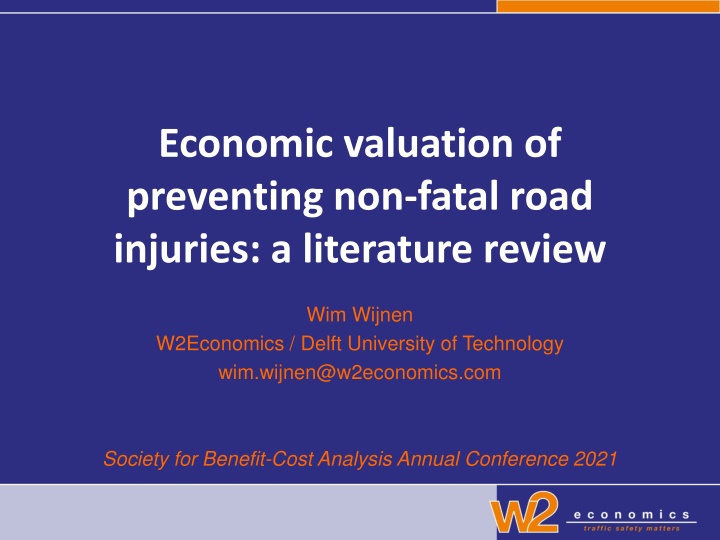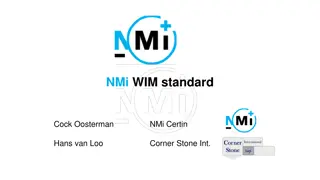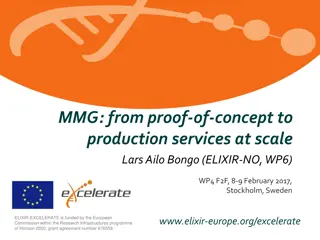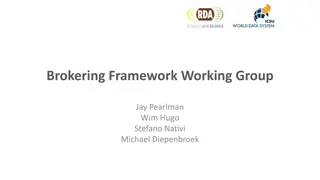
Economic Valuation of Preventing Non-Fatal Road Injuries: Literature Review
Explore the economic valuation of preventing non-fatal road injuries through a comprehensive literature review, focusing on the monetary aspects and methods used for valuation in transportation projects. Key topics include costs per injury severity, valuation methods, and the aim to identify the most suitable approach for preventing road injuries.
Download Presentation

Please find below an Image/Link to download the presentation.
The content on the website is provided AS IS for your information and personal use only. It may not be sold, licensed, or shared on other websites without obtaining consent from the author. If you encounter any issues during the download, it is possible that the publisher has removed the file from their server.
You are allowed to download the files provided on this website for personal or commercial use, subject to the condition that they are used lawfully. All files are the property of their respective owners.
The content on the website is provided AS IS for your information and personal use only. It may not be sold, licensed, or shared on other websites without obtaining consent from the author.
E N D
Presentation Transcript
Economic valuation of preventing non-fatal road injuries: a literature review Wim Wijnen W2Economics / Delft University of Technology wim.wijnen@w2economics.com Society for Benefit-Cost Analysis Annual Conference 2021
Background of the study EU project VIRTUAL Open access virtual testing protocols for enhanced road user safety Cost-benefit analysis of vehicle safety systems projectvirtual.eu PhD-research on interrelations road safety and economic welfare Socio-economic costs of road crashes, including human costs of injuries
Introduction Monetary valuation of preventing road casualties is a key input for CBA of transport projects Literature on monetary valuation of preventing road casualties concentrates of fatal risk; few studies on non-fatal risk
Socio-economic costs of road crashes Distribution by injury severity 100% 90% 80% 70% 60% PDO crashes 50% Slight injuries 40% Serious injuries 30% Fatalities 20% 10% 0% Source: Wijnen & Stipdonk, 2016
Costs per serious road injury Source: Schoeters et al., 2020
Valuation methods and cost components Valuation methods Restitutioncosts approach Costs of resources needed to restore casualties to initial situation Human capital approach Loss of productive capacities of road casualties approach Willingness to pay approach Amount of money individuals are willing to pay for a risk reduction - Medicalcosts - Property damage - Administrative costs Productionloss Human cost
Aim and scope of the study Critically review methods for monetary valuation of preventing non-fatal road injuries Provide an overview of valuations found in the literature Identify most appropriate method(s) for monetary valuation of preventing road injuries
Valuation methods non-fatal injuries Wage-risk studies Revealed preferences Consumerpurchase studies DirectWTP-methods Contingent valuation Stated preferences Stated choice Standard gamble Risktrade-off Valuation methods non-fatal injuries IndirectWTP-methods Trade-off methods Time trade-off Persontrade-off QALY-method
Direct WTP-methods WTP is elicited in a direct way Stated and revealed preferences Stated Choice example (Niroomand & Jenkins, 2016) Source:
Indirect WTP-methods WTP is determined relative to the WTP for a fatal risk reduction Standard gamble, Risk Trade-Off Standard Gamble example (O Reilly et al., 1994) Health state description (example): - In hospital 1-4 weeks in slight to moderate pain - After hospital, recover 1-3 years - Some pain/discomfort, gradually reducing - Some restrictions to work and leisure activities, steadily improving - After 1-3 years, return to normal health with no permanent disability. Option 1: Health loss (hospital admission, pain, disability), no further treatment Option 2: Treatment with 50% chance full recovery, 50% chance of dying Source: O Reilly et al., 1994
WTP-values Study Country Method Value serious injury (% fatality) Value slight injury (% fatality) Direct WTP O Reilly et al., 1994 Persson, 2001 Hojman et al., 2005 Hensher et al., 2009 Hensher et al., 2011 Niroomand & Jenkins, 2016 Niroomand & Jenkins, 2017 Gonzales et al., 2018 UK Sweden Chile Australia Australia Cyprus Cyprus Spain CV CV SC SC SC SC SC SC 32.8-37.5 13.3-26.4 0.9 0.5-1.2 47.0 0.9-4.9 2.7-7.5 0.3 0.9 1.5 2.9 17.0 Indirect WTP O Reilly et al., 1994 Persson, 2001 Persson, 2001 Koyama & Takeuchi, 2004 UK Sweden Sweden Japan SG SG RTO SG 9.5 40.4 38.2 22.4 0.9 32.1 2.3 1.5-2.4 Direct and indirect WTP Olofsson et al., 2019 Sweden CV+SG 1.3-67.0 1.3 Source: own literature search CV: Contingent Valuation; SC: Stated Choice; SG: Standard Gamble; RTO: Risk Trade-Off
QALY-method Two step approach: Determining Quality Adjusted Life Years related to non-fatal road injuries Monetary valuation based on WTP for a QALY (mostly Contingent Valuation)
WTP-values per QALY Country Value per QALY ( 2010) Study Lowest 11,892 4,654 Highest 14,121 125,588 Mean 13,007 30,843 Gyrd-Hansen (2003) Pinto-Prades et al. (2009) Denmark Spain Bobinac et al. (2010) Netherlands 9,838 25,108 16,627 Zhao et al. (2010) Bobinac et al. (2012) China Netherlands 3,671 1,213 5,693 21,959 4,760 9,389 Gyrd-Hansen & Kj r (2012) Pennington (2013) Denmark 3,040 107,688 38,844 Denmark, France, Hungary, Netherlands, Norway, Poland Spain, Sweden, UK 6,266 23,049 12,210 Robinson (2013) Denmark, France, Hungary, Netherlands, Norway, Poland Spain, Sweden, UK 7,841 43,279 20,161 Shiroiwa et al. (2013) Japan 15,597 77,986 42,499 Bobinac et al. (2014) Netherlands 54,132 244,768 114,665 Source: Ryen & Svensson (2014), own selection
Assessment of the methods Criteria: Theoretical: consistency with welfare economics Reliability: potential bias Ability to cope with different injuries Ethical issues Practicality Theoretical basis Reliability Injury diversity Ethical Practicality Direct WTP - Contingent Valuation - Stated Choice Indirect WTP - Standard Gamble - Risk Trade-Off + - - - +/- + + ++ +/- +/- +/- +/- +/- +/- +/- +/- +/- +/- + + QALY +/- - ++ - +
Conclusions Few WTP-studies on non-fatal road safety risk Values per prevented injury show large variations Stated Choice and QALY-method are the most appropriate methods Combining them can be a promising direction for future research
Thank you for your attention! wim.wijnen@w2economics.com






















